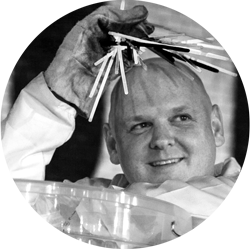
Marcus Neustetter es un artista, activista cultural y productor afincado en Johannesburgo, cuyo contexto se ve reflejado de forma crítica y lúdica a través de su arte y sus proyectos de colaboración. Su estrategia ha sido crear, jugar y experimentar de manera proactiva para construir oportunidades y experiencias para investigar, reflexionar y provocar. Su producción artística –basada mayormente en procesos- ocurre en la intersección del arte con la ciencia y la tecnología, y lo ha llevado a trabajar con un enfoque multi disciplinario que va desde los dibujos convencionales hasta instalaciones in situ –temporales y permanentes-, intervenciones virtuales y proyectos internacionales de involucramiento social.
Nacido en Johannesburgo, Sudáfrica, el 14 de noviembre de 1976, Marcus Neustetter asistió a la Deutsche Schule zu Johannesburg desde 1982 hasta 1994. Cursó la licenciatura en Bellas Artes en la Universidad de Witwatersrand, y obtuvo la maestría en el 2001. Durante este periodo lanza SANMAN (Southern African New Media Art Network). En los últimos 10 años Marcus Neustetter ha estado produciendo y exhibiendo arte y, junto con Stephen Hobbs, se ha mantenido activo en proyectos en común como: The Gallery Premises, The Trinity Session y como Hobbs/Neustetter (www.onair.co.za ).
Entre sus reconocimientos recientes se incluyen: ganador del World Technology Award for the Arts 2015 (Nueva York), Artist in Research Fellowship para the Smithsonian National Museums of African Art and Air and Space (Washington DC), performance público encomendado por el Año Internacional de la Luz de la UNESCO (Mérida, México) y el proyecto Renombrando la Ciudad (Renaming the City, Linz), encomendado por the Ars Electronica Festival a The Trinity Session en respuesta a los retos actuales que vive Europa con el tema de los refugiados.
Johannesburg based artist, cultural activist and producer, Marcus Neustetter, reflects critically and playfully on his context through his art and collaborative projects. His strategy has been to pro-actively create, play and experiment to build opportunities and experiences that investigate, reflect and provoke. Mostly process driven, his production of art at the intersection of art, science and technology has led him to work in a multi- disciplinary approach from conventional drawings to permanent and temporary site specific installations, mobile and virtual interventions and socially engaged projects internationally.
Born in Johannesburg, South Africa, on the 14 November 1976, Marcus Neustetter attended the Deutsche Schule zu Johannesburg from 1982 to 1994. He read for his Bachelor of Arts in Fine Arts at the University of the Witwatersrand, earning his Masters Degree in 2001. During this time he launched sanman (Southern African New Media Art Network). In the past 10 years Marcus Neustetter has been consistently producing and exhibiting art and, in partnership with Stephen Hobbs, has been active with The Gallery Premises, The Trinity Session and in their collaborative capacity as Hobbs/Neustetter (www.onair.co.za ).
Recent accolades have included winner of the World Technology Award for the Arts 2015 (New York City), Artist in Research Fellowship for the Smithsonian National Museums of African Art and Air and Space (Washington DC), a commissioned public performance for the UNESCO International year of Light (Merida, Mexico) and a commission as The Trinity Session by the Ars Electronica Festival in response to the current refugee challenges in Europe with their project Renaming the City (Linz).
Marcus Neustetter juntúul j its’at, j péektsil miatsil yéetel productor kaja’an Johannesburgo, tu meyaj yéetel le ku múul beetike’ ku ye’esik ba’ax ku tukultik yo’olal ba’alo’ob ku yúuchul. Ts’o’ok u kanik u patjo’olt túumben ba’alo’ob, báaxal yéetel u xak’altik bix u beeta’al nu’ukulo’ob ts’áak u páajtalil u yantal xak’al meyaj, tuukul yéetel ka úuchuk uláak’ ba’alo’ob. U yits’at meyajile’ –suuka’an u beetik yéetel procesos- ku yúuchul tu’ux ku múuch’ul ciencia yéetel túumben ba’alo’ob, le beetik ts’o’ok u meyajtik jejeláas ba’alo’ob je’el bix boon suuk u beeta’al tak instalaciones in situ –chéen jun súutuk yéetel mantats’ p’ata’anil-, tu’ux u beetmaj meyajo’ob ti’ táanxel lu’umo’ob tu’ux ku táakbesik kaaj.
.
